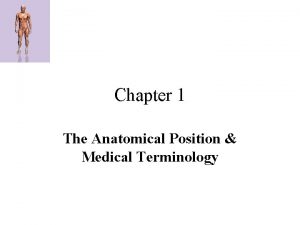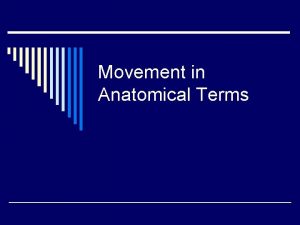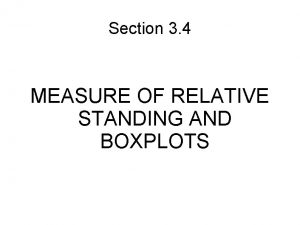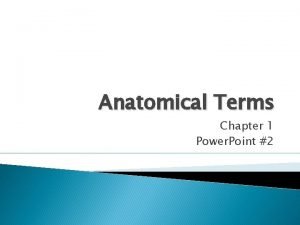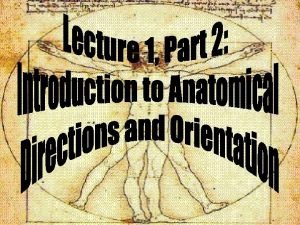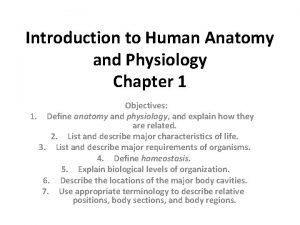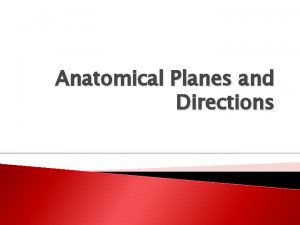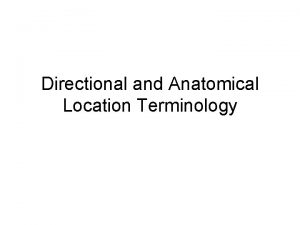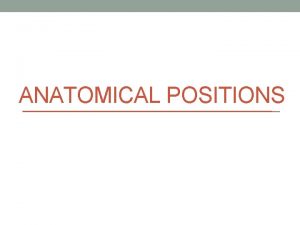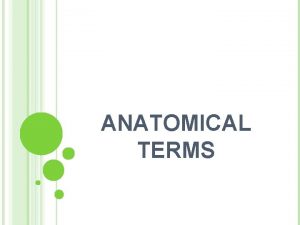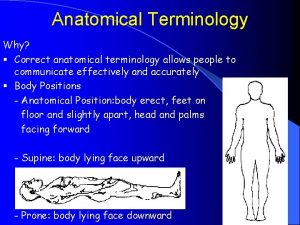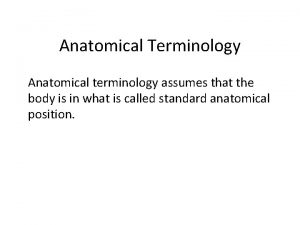Anatomical Terminology Relative Position Anatomical Position is standing













- Slides: 13

Anatomical Terminology

Relative Position • • Anatomical Position is standing erect the face is forward upper limbs are at the sides • the palms forward.

Relative Position • To be anyone in a medical profession you must know anatomical terms. • Terms of relative position are used to describe the location of one body part with respect to another. They include the following….

Superior/ Inferior • Superior • means a part is above another part or closer to the head. (The thoracic cavity is superior to the abdominopelvic cavity. ) • Inferior • means a part is below another part or toward the feet. ( the neck is inferior to the head)

Anterior/Posterior • Anterior-(Ventral) • means toward the front. (the eyes are anterior to the brain) • Posterior-(dorsal) • means toward the back. (the pharynx is posterior to the oral cavity)

Medial/Lateral • Medial • relates to an imaginary midline dividing the body into equal right and left halves. (the nose is medial to the eyes) • Lateral • means toward the side with respect to the imaginary midline. (the ears are lateral to the eyes)

Ipsilateral/Contralateral • Ipsilateral • pertains to the same side (the spleen and the descending colon are ipsilateral). • Contralateral • refers to the opposite sides. (the spleen and gallbladder are contralateral).

Proximal/Distal • Proximal • is used to describe a part that is closer to the trunk of the body or closer to another specified point of reference than another part. (the elbow is proximal to the wrist) • Distal • it means a particular body part is farther from the trunk or farther from another specified point of reference than another part. (the fingers are distal to the wrist).

Superficial/ Peripheral • Superfical • means situated near the surface. (the epidermis is the superficial layer of the skin) • Peripheral • also means outward or near the surface. Used to describe the location of certain blood vessels and nerves. The nerves that branch from the brain and spinal cord are peripheral nerves)

Body Plans/Sections

Body Planes/Sections • Sagittal • (median plane)- refers to a lengthwise cut that divides the body into right and left portions.

Body Planes/Sections • Transverse • (horizontal)- refers to a cut that divides the body into superior and inferior portions.

Body Planes/Sections • Coronal • (frontal)- refers to a section that divides the body into anterior and posterior portions.
 Directional terms - examples
Directional terms - examples Fundamental position vs anatomical position
Fundamental position vs anatomical position Difference between standing crop and standing state
Difference between standing crop and standing state Measures of relative standing and boxplots
Measures of relative standing and boxplots Second position ballet
Second position ballet Anatomical position
Anatomical position Anatomic positions
Anatomic positions Erect position medical terminology
Erect position medical terminology What does erect mean in anatomy
What does erect mean in anatomy Cross section of abdomen
Cross section of abdomen Palms facing posteriorly
Palms facing posteriorly Definition of homeostasis
Definition of homeostasis Trendelenburg position
Trendelenburg position The body planes
The body planes
